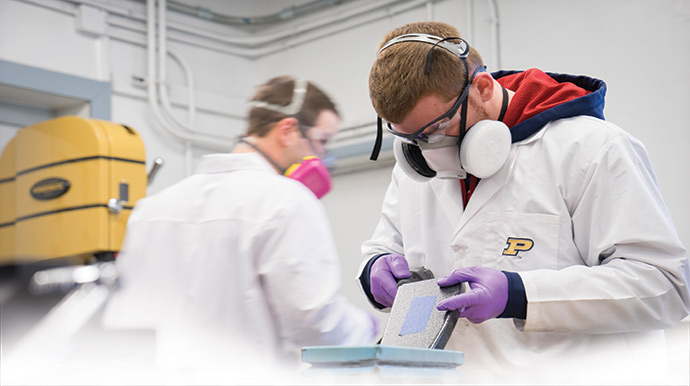Purdue’s Composites Manufacturing and Simulation Center, which opened its doors in 2016, is taking a lead role in a national industrial priority. Under the leadership of the U.S. Department of Energy, the center and its teams of faculty and graduate researchers are exploring ways to ignite production of a new generation of manufacturing materials that are more dynamic, increasingly lighter, and thus more sustainable than existing metals and plastics.
The DOE project at Purdue is part of a five-year, national collaboration involving industry, economic development agencies and institutions of higher learning in six heavy manufacturing states, including Indiana. The push includes a $70 million commitment by the federal government and $180 million from its partners.
“The advanced composite market is poised for dramatic growth,” says Purdue President Mitch Daniels. “This important public-private partnership has a strong research, development and deployment mission focused on advancing the use of composite materials such as carbon fiber to make lighter-weight cars, wind turbines, natural gas storage tanks and other products.”
Advanced composites are the coming progression in mass-produced manufacturing materials that began with metals and metal alloys, progressed into plastics and such simpler composites as fiberglass and graphite, and eventually into materials with ever-increasing degrees of performance and specialization. Advanced carbon fiber, for example, is already used in the bodies of high performance sports cars, space vehicles, and, perhaps most visibly, in the Boeing 787 Dreamliner, whose fifty-percent advanced composite frame makes it lighter and saves a substantial 20-percent on fuel consumption.
It’s a major departure from traditional manufacturing processes. Rather than casting objects and welding them into place, the process known as additive manufacturing works off computer software, builds an object by laying down ultra-thin layers of manufacturing material, subjecting them to heat via lasers, and then “printing” the final product. The process allows greater flexibility in creating intricate shapes, requires less human labor and eliminates significant waste material.
The trick has been to get advanced composites production out of the exotic and into the mainstream. In its present formulation, the process requires expensive machinery and deep technical know-how.
“It takes an enormous amount of time to invest in teaching people to do things differently,” says Byron Pipes, executive director of the Composites Manufacturing and Simulation Center. “Plastics,” says Pipes, “replaced metals and wood, but we had to develop a whole knowledge base of engineers. That happened in the 50s and 60s. Composites started in the 70s and we still have a very small subset of the engineering community who actually understand how to design with these materials or how to estimate what it would cost to make a product.”
The composites manufacturing team led by Pipes is headquartered in the impressive new Indiana Manufacturing Institute, a $50 million research center just north of Purdue’s main campus. The sprawling 62,000-square-foot compound is embedded within Purdue Research Park, the largest university-affiliated incubation complex in the country
Ron Sterkenburg, a professor of aviation technology at Purdue, is also part of the DOE-funded composites research effort. Sterkenburg says the collaborative nature of Purdue’s manufacturing institute brings significant advantages to an array of research projects.
“The great thing here is that we are working together. We are helping each other. That makes these projects more efficient, and it helps us all understand the whole process from conceptual to testing to manufacturing.”
Purdue’s emerging pool of talent in additives manufacturing is winning lots of attention from industry.
“We have companies,” says Pipes, “that want to come show us their problems and then they want to talk to all of our students about coming to work for them. The human talent base in this field is still so small. And we’re among the few producing the most desired people.”
Turbo Charged
Few places in the world can offer the level of research and testing on turbomachinery technology as the Notre Dame Turbomachinery Laboratory (NDTL) in South Bend at the university’s 28,000-square-foot facility in Ignition Park. The lab provides research and testing for a variety of industries including aviation, power plants and the oil and gas industries.
“The capabilities we provide here are completely unique for any university in the United States, within this field there is no other university in the country that can do what we do. It’s even unique globally… it really is a world-class laboratory for this sort of work and we’re getting a lot of attention from the global community.”
Over the past decade, the lab has worked with the Office of Naval Research, the Air Force Research Laboratory, the Air Force Office of Scientific Research and NASA. Most recently the lab has partnered with Korean company, Doosan Heavy Industries and Construction Co. Ltd., to research and develop a 300-megawatt class power generation gas turbine in a $25-million contract for 19 months. Testing for this project will occur at the lab’s 10MW compressor test cell, which is currently under construction and is expected to be completed by the end of the year and will be one of the largest university compressor research facilities in the world.
Producing the Engineers of the Future
Indiana, which is home to some 34,000 engineers, is deeply immersed in advanced engineering, particularly aviation engineering, at institutes of higher learning. Beyond Purdue, the state’s engineering talent pipeline includes:
- Notre Dame, home of the Hessert Laboratory for Aerospace Research, a leading research facility for both public and private organizations.
- Indiana State University. ISU offers degrees in Aviation Management and Professional Aviation Flight Technology, with minors in Aviation Technology and Unmanned Systems.
- Ivy Tech Community College in Indianapolis, which offers an Aviation Manufacturing program with industry-driven certifications.
- Rose-Hulman Institute of Technology in Terre Haute. Rose-Hulman was voted a number-one school for undergraduate engineering by U.S. News and World Report.
- Vincennes University Aviation Technology Center. Located at Indianapolis International Airport, the branch of Vincennes University offers Airframe and Power Plant certifications and an Aviation Maintenance and Technology degree.

